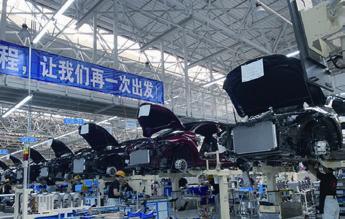Sweetening the Offer as Global FDI Bright Spot
2019-11-27

China continues to see an uptrend in foreign direct investment (FDI) infl ow as investors remain bullish on tapping into a huge market with growing ease of doing business.
Data from the Ministry of Commerce(MOFCOM) on November 18 showed that FDI into the Chinese mainland expanded 6.6 percent year on year to 752.41 billion yuan($107 billion) in the fi rst 10 months of the year.
In October, Chinas year-on-year FDI growth almost doubled from that of September. The 7.4-percent rise is enviable given the signifi cant uncertainties that could impact the scale and contours of FDI in 2019 and 2020.
According to the latest Global Investment Trends Monitor report by the United Nations Conference on Trade and Development, global economic growth has fallen and growth forecasts have continued to be revised downward this year. Geopolitical risks, trade tensions and concerns about a shift toward more protectionist policies have further weakened business confi dence.
MOFCOM official Zong Changqing said Chinas FDI infl ow was stable and featured more major projects as well as an improved structure in the January-October period.
“More than 1,300 major projects with investment of more than $50 million have been launched this year, up 5.4 percent from the same period last year,” Zong said.“Implementation of projects above the$10-billion mark, such as those with BASF, ExxonMobil and Tesla, is speeding up.”
In addition, MOFCOM data showed that 33,407 new foreign-funded enterprises were established in the fi rst 10 months of the year. Foreign investment in hi-tech industries surged 39.5 percent year on year to 222.4 billion yuan ($31.65 billion), accounting for nearly 30 percent of the total FDI.
Foreign companies have long benefi ted from and contributed to Chinas development. They accounted for nearly half of the countrys foreign trade, one fi fth of tax revenue and one fourth of total output of major industrial enterprises, said a report on multinationals by a research institute under MOFCOM.
Their importance makes stabilizing foreign investment a key task of Chinas six-plank campaign to counter downward economic pressure. The other tasks are stabilizing employment, the financial sec- tor, foreign trade, domestic investment and expectations.
“The Chinese economys high-quality development requires foreign investment to play a bigger role in research and development, technology, and capital and human resources,” said Hao Hongmei, a researcher with the Chinese Academy of International Trade and Economic Cooperation under the ministry, according to 21st Century Business Herald. “This is where the new round of foreign investment policies can be highly instrumental.”
Hao referred to a recent guideline issued by the State Council on making better use of foreign investment with a focus on safeguarding the national treatment of foreign-funded enterprises. The guideline puts forward 20 policies in four aspects to create a more “fair, transparent and predictable” business environment for foreign investors.
The guideline refl ects Chinas latest efforts to facilitate foreign investment. China has introduced the pre-establishment national treatment plus a negative list management system and substantially eased restrictions on market access for foreign investors, with marked progress in improving the legal and policy framework.
“We are optimistic about achieving this years goal of stabilizing foreign investment,” Zong said, citing the pro-investment measures.
According to the latest World Bank report, Chinas ease of doing business ranking rose to 31 this year from 46 last year, and it is also among the top 10 economies that improved the most on the ease of doing business index after implementing regulatory reforms.
“We are very pleased to see the Chinese Governments continued efforts to provide foreign-invested enterprises a friendly and dynamic business environment, as well as vast possibilities in innovation,” said Jerry Wang, President of Siemens Healthineers Greater China.
